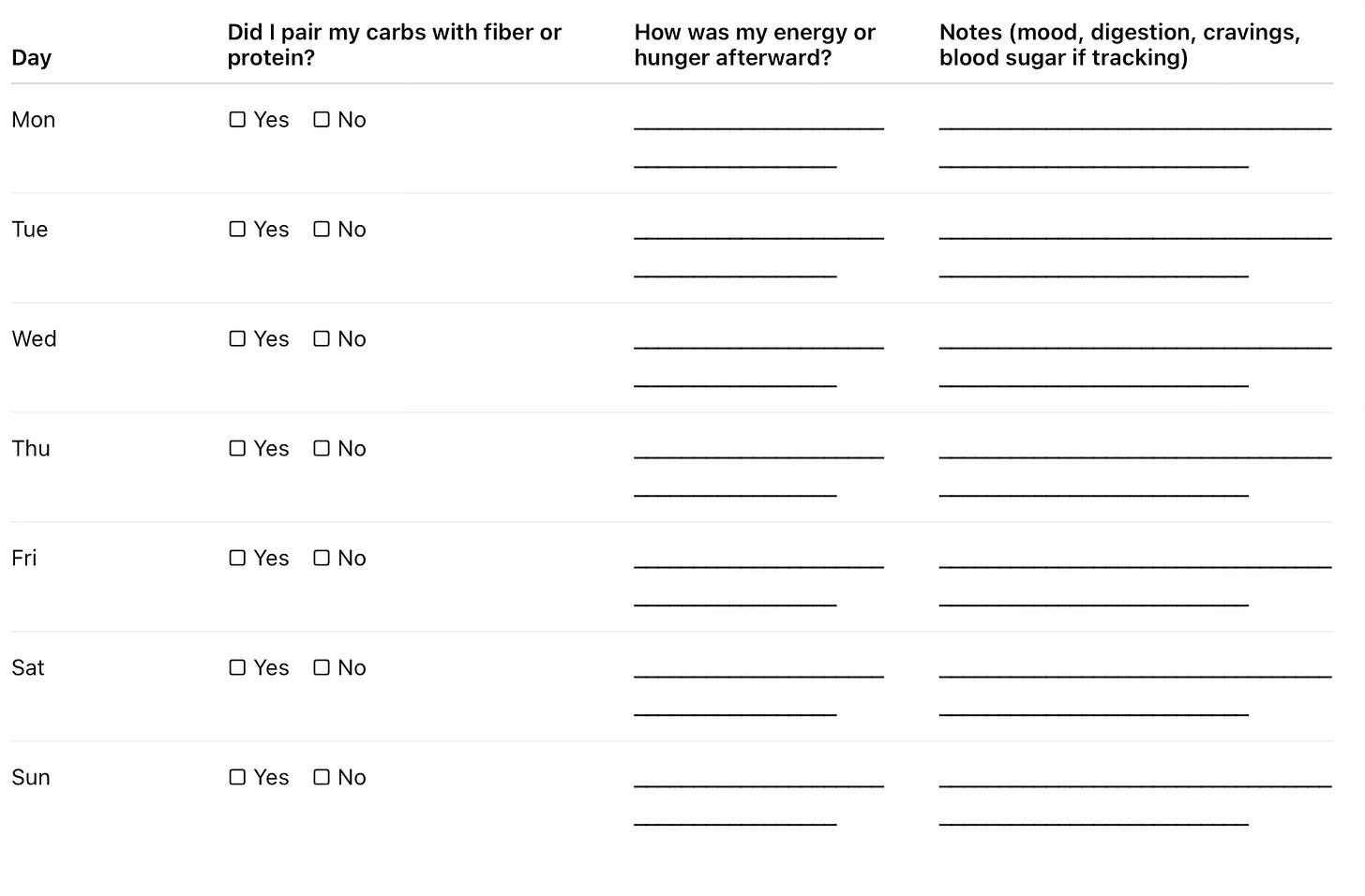If there were a Most Misunderstood Food Award, carbohydrates would win by a landslide.
They’ve been called evil. Blamed for weight gain. Labeled “bad.” Feared by millions.
And yet… they’re literally your body’s preferred source of fuel.
Your brain runs on them. Your muscles depend on them. Even your red blood cells live on glucose, which comes from—you guessed it—carbs.
So why the hate?
Let’s unspool this one together. Because if you’ve ever been afraid to eat fruit, confused by “net carbs,” or sworn off bread only to binge on crackers later… this one’s for you.
First, What Are Carbohydrates?
Carbohydrates are one of the three macronutrients (along with protein and fat). They come in many forms, simple, complex, whole, refined, but in the end, your body breaks them down into glucose, which it uses for energy.
Think of carbs as kindling. Some burn fast, some slow, but they all feed the fire.
Here’s the nuance:
Simple carbs break down quickly and can spike blood sugar. Think white bread, soda, candy, pastries.
Complex carbs are slower-burning, often full of fiber, and release glucose gradually. Think beans, lentils, oats, sweet potatoes, vegetables.
Your body doesn’t hate carbs. It hates chaos. And many modern carb sources—processed, stripped of fiber, eaten on the go cause chaos.
The Problem Isn’t Carbs. It’s Context.
Let’s say you eat a banana.
That banana doesn’t float through your bloodstream as guilt.
It doesn’t automatically spike your insulin.
It’s not waiting to betray you.
What happens next depends on context.
Did you eat it alone on an empty stomach or after a fiber-rich meal?
Are your cells insulin sensitive or resistant?
Are you active or sedentary all day?
The same carbohydrate behaves very differently in a healthy metabolic system versus a stressed, insulin-resistant one. That’s why some people can eat rice and feel great, while others crash and crave sugar an hour later.
This is not about judgment. It’s about metabolic individuality.
But the solution isn’t to eliminate all carbs. It’s to retrain your system to handle them better.
And that starts with how you eat them.
The Carbohydrate Chain Reaction
When you eat a highly processed carb, say, a plain bagel on an empty stomach, it digests fast, hits your bloodstream like a sugar bomb, and triggers a rush of insulin. Your body scrambles to bring that blood sugar down quickly.
What follows?
A drop in energy
Hunger that doesn’t match your caloric intake
A craving for more carbs
A spike–crash–repeat loop that wears out your insulin system
Now compare that to eating a bowl of lentils with vegetables, herbs, and a drizzle of lemon. Same total grams of carbohydrate? Possibly. But fiber, protein, and real food context change everything.
The blood sugar rise is slower. The insulin response is gentler.
And your appetite? Steadier, calmer, easier to trust.
Micro Habit: Pair Every Carbohydrate with Fiber or Protein
You don’t have to fear carbs, you just have to respect their speed. Think of protein and fiber as traffic calming agents. They slow the release of glucose, ease the insulin load, and help your body process fuel more efficiently.
Try this:
Add beans or lentils to your grain bowls
Pair fruit with a tablespoon of flax or chia seeds
Eat starchy vegetables alongside leafy greens
Top toast with hummus or avocado, not just jam
The goal isn’t perfection. It’s combination.
This simple pairing habit helps prevent spikes, reduces crashes, and trains your body to handle carbs with more grace.
Over time, this reduces insulin resistance, not by restriction, but by regulation.
Let’s Rethink the Narrative
Carbs aren’t the problem. Confusion is.
We’ve blamed the banana instead of looking at the system.
We’ve punished ourselves for cravings without understanding the loops that cause them.
You don’t need to be afraid of the foods that once made you feel good.
You just need to learn how to eat them in a way that supports healing.
Start with one pairing. Start with “C.”
Because when you understand how carbs work, they stop controlling you and start fueling you.
You’re just one healing habit away.
If this post helped bring clarity, please restack it, forward it, or share it with someone else who’s still stuck in the fear. We don’t need more restriction we need more education. And more support.
Let’s help each other heal. One bite. One habit. One post at a time.
Coming Up Next:
D is for Dawn Disruption.
Ever wondered why your blood sugar is high before you eat? You’re not alone. In this article we unpack the hormonal patterns behind early morning spikes, what they reveal about your liver, stress, sleep, and insulin resistance. It’s one of the most common questions I get and one of the most misunderstood.
Just in case you missed last week’s, B is for Blood Sugar Basics, you can read it here.
Want to Go Deeper?
If today’s post helped you rethink your relationship with carbs, you’ll love what we’re unpacking inside The Habit Healer’s Mindset Inner Circle.
Every I send Inner Circle members:
A private, in-depth guide on one key habit or healing insight
Science explained with clarity, stories, and soul—not jargon
Practical tools, weekly micro habits, and reflection prompts that build real momentum
Full access to the archive of past Inner Circle guides and habit trackers
Inside, we don’t cut carbs.
We cut confusion.
We don’t chase perfect.
We build better.
Subscribe now to join the Inner Circle.
Because healing your metabolism isn’t about restriction—it’s about knowing what actually works for your body, and repeating it with purpose.
You’re just one healing habit away.
Worksheet: C is for Carbohydrates
Support Blood Sugar by Pairing Carbs with Fiber or Protein
Section 1: What You Learned
Fill this out after reading the article.
What surprised you most about how carbohydrates work in the body?
Which types of carbs do you feel most confused or conflicted about?
What carb pairing strategies have you tried before—if any?
Section 2: Your Micro Habit This Week
Practice pairing every carbohydrate you eat with fiber or protein. Track how it affects your energy, cravings, and satiety.
My most common carb choices this week:
My go-to pairing options (fiber or protein):
Tracking Grid:
Section 3: Reflection
At the end of the week…
What did you notice when you consistently paired your carbs with fiber or protein?
Did your energy, hunger, or cravings shift in any noticeable way?
What would you like to continue or adjust next week?







I wasn't getting nearly enough protein and it feels like I have lost a lot of muscle, so I made a breakfast habit instead of skipping breakfast: a smoothie of milk (or 8 oz.plain yogurt when funds allow), 6 oz. of fruit, and a couple of scoops of protein powder (net 30g for the powder). It tastes awfully sweet. In addition to the sugar-mitigating protein, I am going to add a tablespoon (or two) of flax meal.
I am 75. Your substack is waking me up to what I have done to myself, and the fact that I had felt like the engaged part of my life was over, and now was just for finding easy, low-effort things to do with my time until I die. I am seeing that this is a decision. The first 5 micro habits are now established. Breakfast too, and last night I started some strength-building exercises. Right now only 3, 5 reps each, and next week I will start adding reps. Go me! Without your substack this never would have happened.
I could cry from relief at the simplicity of how you share things! Thank you.